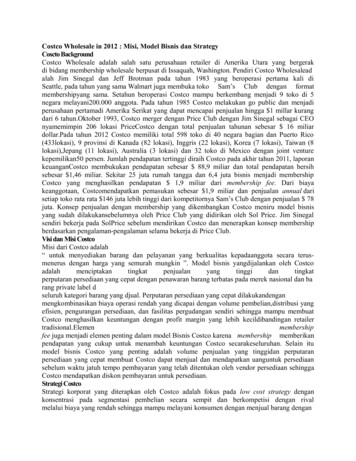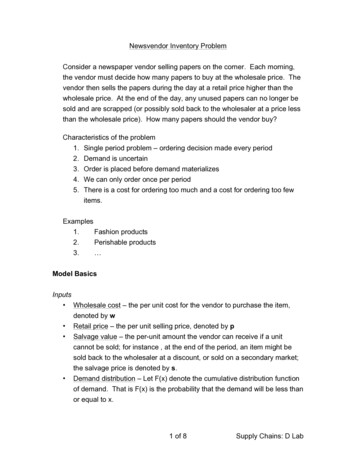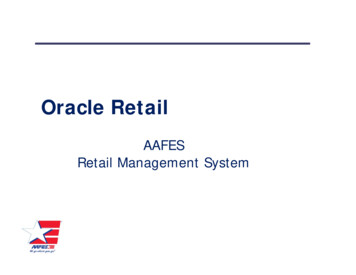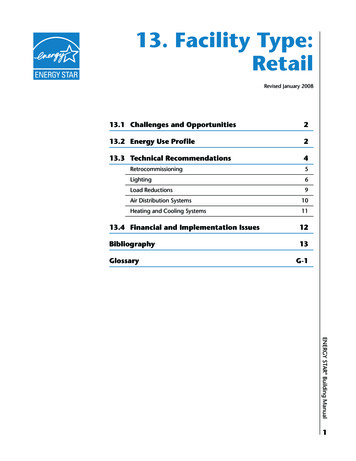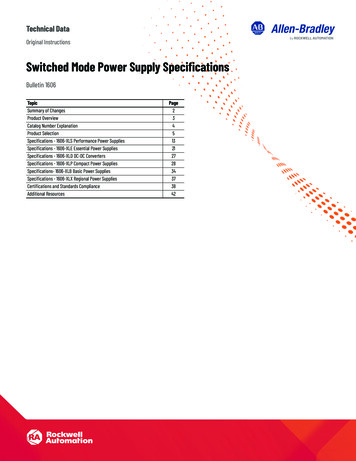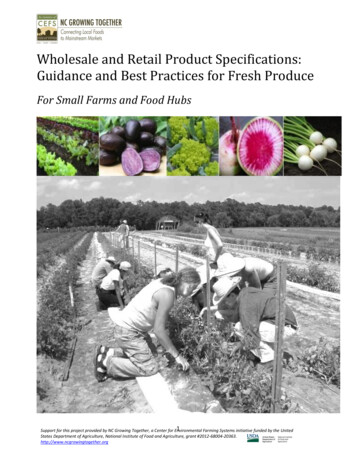
Transcription
Wholesale and Retail Product Specifications:Guidance and Best Practices for Fresh ProduceFor Small Farms and Food Hubs1Support for this project provided by NC Growing Together, a Center for EnvironmentalFarming Systems initiative funded by the UnitedStates Department of Agriculture, National Institute of Food and Agriculture, grant #2012-68004-20363.http://www.ncgrowingtogether.org
PURPOSEA key objective of the North Carolina Growing Together Project (NCGT), aCenter for Environmental Systems Initiative, is to provide information andsupport to producers and organizations to help them sell into retail andwholesale markets. This guide was developed to assist growers in meetingproduct specifications specific to NCGT project partners.1 The pack sizes hereare the most commonly used, but are subject to change. It is recommendedthat growers contact buyers directly to confirm specifications.The grade standards system is a key tool used in the fresh produce market.Agricultural products can have highly variable characteristics, includingvariation in weight, size, shape, density, firmness, tolerance to insect damage,cleanliness, color, taste, and blemishes. Agreed-upon standards that establishacceptable criteria for each of these characteristics allow buyers and sellers toconnect and do business more efficiently.The United States Department of Agriculture (USDA) is the source of industrystandards. Failure to meet these standards results in buyer rejection ofproduct with the seller often charged for shipping. Rejection hits small farmsparticularly hard because it may mean that a large portion of the crop must besold at a loss. Many small farms throughout North Carolina have beensubjected to rejection and, ultimately, loss of income because of failure tomeet industry standards.This manual has been developed to assist individual growers and growerbased distributors and food hubs by (1) outlining a clear set of descriptiveguidelines for quality, size, labeling, packaging and USDA grade classification;and (2) providing guidance on how to improve the presentation of theirproduce in the marketplace in order to enhance sales to retailers andwholesalers.1This guide was prepared by Patricia “Trish” Tripp, Wholesaler Liaison, NC Growing Together project.For more information see ncgrowingtogether.org.1
HOW TO USE THIS GUIDEThis guide is intended to be a resource for the day-to-day handling of freshproduce and as a training guide for small to mid-sized producers and foodhubs. It provides relevant information for NCGT grower and distributorpartners. At times, a retailer or wholesale buyer may request a uniquecharacteristic or pack size for a product; it is important for producers tocontact buyers to confirm that the recommended pack sizes in this guide areappropriate.WHAT ARE THE GRADES FOR FRUITS AND VEGETABLES?Fruit and vegetable grade standards are set by the USDA. The purpose of thestandards is to describe, in a uniform language, the quality and condition ofcommodities traded in the produce industry. Fruits and vegetables are gradedfor fresh markets and for processing, with each fruit and vegetable having itsown set of standard grades and terminology. This guide will focus on US #1grade for fresh markets (wholesale and retail).The USDA maintains a list of fruits and vegetables and their specific vegetablestandardsMAINTAING THE QUALITY OF YOUR PRODUCTWhen entering commercial markets it is important to ensure that the qualityof your product is maintained for the shelf life anticipated by the buyer. Theshelf life of a vegetable is how long a product is usable/saleable post-harvest.Unlike selling from a roadside stand or the farmers’ market, where theconsumer takes immediate possession of the product, it takes time forwholesalers and retailers to transport product to the end user.If proper harvesting, storage and distribution protocols are not followed, theseller is at higher risk of the buyer returning/rejecting the product. If theproduct is not marketable, chances are high that the wholesaler and/orretailer will ask the producer to credit them what they previously paid for thisproduct. Producers selling “locally” need to match (or exceed) the quality ofexisting wholesale options, especially if producers are trying to obtainpremium prices for their product.2
Here are a few tips to assist you in increasing the quality and safety of theproducts that you grow or sell.HarvestingHarvest early in the morning when the temperature of the produce is cooler.Once the product is harvested, place harvest boxes or bins under loose coversfor shade if the produce cannot be quickly removed from the field. Produceleft out in the sun absorbs heat and may also become sunburned, reducingquality and shelf life. Provide shade while transporting your produce.Keeping the produce as cool as possible will result in the longest shelf life.The most effective practice to increase shelf life is pre-cooling to remove fieldheat. This can be accomplished by placing harvested produce in a coolingroom or walk-in cooler. Pre-cooling provides several benefits, includingslowing down the rate of respiration, minimizing susceptibility of harmfulmicroorganisms and reducing water loss of your product.Sorting and GradingBuyers seek consistency of size and color in each case of product. Sorting andgrading can be done in the field, not just in the packing shed. Sorting is doneon the basis of size and color and grading is based on defect, both of whichdetermine if a product is marketable.StoringWhen produce is at its peak harvest, it may be necessary to store the productinstead of delivering it immediately to your customer. If this is the case,storing product at optimal storage temperatures is important. This guideprovides optimal storage temperatures for specific crops.LabelingMost wholesalers and retailers require some sort of label for your product. Ifyou sell your product by the case, then each case should be labeled. If you sellyour product by the pallet, then each pallet should be labeled. At a minimum,the label should include a unique lot number, the farm name and location, theproduct name, pack-size and the words “Product of the USA”. This label will3
satisfy the traceability requirements of most wholesalers and retailers.However, the buyer may also request a GS1 barcode label. GS1 is aninternationally used set of numbers applied to products, companies andservices to allow for supply chain tracking.For information on GS1 Company Index numbers, s1-us.If selling into the retail market, the buyer may require that a PLU (ProduceLook-up) sticker be placed on individual products. Industry-wide itemnumbers are assigned to specific products. For example, broccoli is assignedcode #4060.For more information, visit: http://plucodes.com/docs/users guide.pdfThe Produce Traceability Initiative (PTI) is an initiative to improvetraceability of products. If you are GAP (Good Agricultural Practices) certified,you are required to maintain a traceability plan, “one step back” (internal toyour operation) and “one step forward” (external to your operation). The PTIuses a Global Trade Item Number (GTIN) to achieve external traceability. Thisitem number will be specific to the crop you are growing. In addition, if yourbuyer requests a GS1 barcode label, you will need to register for a GS1number, which is unique to your farm and will need to be added to everybarcode and/or identification number that you create for your products.For more information on the Produce Traceability Initiative, ny produce crops require cooling and/or cool transport to maintainproduct quality and safety. Maintaining a 100% cold supply chain not onlyincreases product shelf life, but also decreases microbial contamination risks.Documenting a 100% cold supply chain is a requirement to sell into manywholesale and retail markets, and even if not required will make your productmuch more competitive and desirable to wholesalers and retailers.4
Price DataThe North Carolina Department of Agriculture & Consumer Services collectswholesale fruit and vegetable price data daily from select wholesalers locatedat the Raleigh Farmers Market. These daily reports can be obtained on theMarket News page within the Markets Division on the NCDA&CS website.In response to producers’ interest in historical market prices the NC GrowingTogether Project collected and digitized these prices for the years 2008through 2013 for the products in this manual, recording prices from eachThursday report. This pricing data can be downloaded esale-prices-2008-2013.xlsxMore InformationFor more information on selling into retail and wholesale markets, includinga visual guide on the process of warehouse receiving and distribution of freshproduce at a regional distribution center, rs/Also visit the NC Local Food Web Portal for links to additional resources:http://localfood.ces.ncsu.edu/5
Product Reference ListProductPageApplesAsparagus, GreenBeansBeetsBell Pepper, Green or umbersEggplantGreens - CookingLettucePotatoesSummer SquashSweet CornStrawberriesTomatoesTurnipsWatermelonWinter ssary of terms296
ApplesQuality apples are fairly well formed, little to no bruising, good colorGeneraland firm.Characteristics:Harvest Guidance: Daily, early morning harvest is recommended To ensure maximum storage life, apples should be harvested when maturebut not yet fully ripe or overripePost-Harvest Guidance:Pre-CoolingForced air (room cooling is acceptable) to 32-36 degrees F.Washing/Processing Brushed or washed (Do not wash for long-term storage)U.S. #1Uniform sizing and fairly well formed, little to no bruising,Size/Appearancegood color. Must be free from visible watercore. Somerusseting may be tolerated (refer to USDA for acceptabledefects).Diameters: 2 ¾ inches - 125 ct. and 3 ½ inches – 100 ct.PackingWholesale: Bushel apple box, 40 lbs. Tray Pack 100-125 ctBushel apple box, 40 lbs. loose – 100-125 ctRetail: Bushel apple box, 40 lbs. Tray Pack 100-125 ct; PLUrequired.Note: Certain specialty varieties may be packed in smallercase packs at the request of the customer.Optimal StorageTemp 30 – 40 F; Humidity 90-95%Shelf Life100-230 days7
Asparagus – GreenGeneralCharacteristics:Quality asparagus will be dark green with a tightly closed andcompact tip. Early season asparagus can exhibit more of a purpletinged tip and a paler, apple green stalk. The asparagus should besized fairly consistently within the case.Harvest Guidance: Daily, early morning harvest is recommended. Break off the stalk near the soil surface, taking care to not break the crownof the plant buried beneath the spear. The asparagus should break fairlyeasy when ready to harvest. If needed you may need to break the asparagusoff higher, moving further away from the woody part of the plant. Harvested stalks should be 8-11” in length with a stem diameter that shouldbe over ¼”; It is recommended that you avoid woody stems. Harvest into sturdy clean containers placing the cut end of the spears in 1” ofcool potable water. Keep in shaded area.Post-Harvest Guidance:Pre-CoolingRapid hydro-cooling is recommended; Keep stalks standingupright in 1” of water; Keep shadedWashing/Processing Trim spears to uniform height; gently rinse with potablewater as neededU.S. #18”-11” stalks with closed bracts; grade by stem diameter intoSize/Appearance2 distinct sizes; Unless otherwise specified, requires a ½ inchminimum diameter.PackingWholesale: 24 x 1 lb. banded bunches (upright)1 1/9 bushel boxRetail: 24 x 1 lb. banded bunches (upright)1 1/9 bushel boxOptimal StorageShelf LifeTemp 32 – 35 F; Humidity 95-99%14-21 days8
Beans, Green or SnapGeneralCharacteristics:Quality/ripe beans should be relatively straight and snap easily whenbent. Immature beans will appear thin and very dark in color whileover-mature beans appear very plump and pale in color, which arenot marketable.Harvest Guidance: Early morning harvest is recommended every 2-4 days Typically harvested 15-18 days following full bloom Harvest when the pods are firm, crisp and fully elongated, but before the seedwithin the pod has developed significantly Keep stem end intact when harvesting Harvest when dry Keep in shaded areaPost-Harvest Guidance:Pre-CoolingHydro-cooling ,forced air, room cooling (dry completely);Caution: Beans are sensitive to freezing injury.Washing/ProcessingU.S. #1Size/AppearanceIf washing is needed air dry completely; Fans may be used.4-6” in length, free of damage, firm, tender and fairly straight;Clean; Any russeting will increase when product is kept atroom temperature, so any russeting is considered a defectand will not be graded as U.S.#1.PackingWholesale: 25 lb. - 1-1/9 Bushel BoxRetail: 25 lb. – 1-1/9 Bushel Box; loose or 5-5lb. bagsOptimal StorageStorage LifeTemp 40 – 45 F; Humidity 95% - 100%10-14 days9
BeetsGeneralCharacteristics:Quality beets should be of uniform shape and size, firm and fairlysmooth with intense uniform color typical of the variety. Bunchedbeets or beets with short-trimmed tops shall have tops that are freshand free from decay and/or discoloration.Harvest Guidance: Bunched beets should be harvested at 50-70 days. Bunched beets should be 1-1/4 lb. per bunch (3-5 beets) and can be bunchedin the field. Topped beets should be harvested before they reach full maturity. Use clean knife to top and tail beets. Leave at least ½ inch of the long root. Use a bucket of cold water or a refrigerated truck to immediately cool beets.Post-Harvest Guidance:Pre-CoolingTopped: Room coolingBunched w/tops: Hydro-cool in water as quickly as possible.Washing/Processing Wash or brush the root if needed;U.S.#1Unless otherwise specified, beets should be at least 1-1/2Size/Appearanceinches in diameter. Bunches must weigh at least 1.1 lb. andmust contain at least 3 beets.PackingWholesale: Topped: 25 lb. in a 5/9 waxed carton w/polyethylene liners; 40 lb. in a 1-1/9 waxed cartonBunched (using rubber band or ties) w/tops: 12 bunches in a1-1/9 carton; 24 bunches per case in a leafy greens waxedbox.Retail: Bunched w/tops: 12 bunches in a 1-1/9 carton; 24bunches per case in a leafy greens waxed box.Optimal StorageTemp 32 F (bunched) 33 F - 36 F (topped); Humidity 98%Shelf LifeTopped: 3-5 months; Bunched: 10-14 Days10
Bell PepperRed, Yellow & GreenGeneralCharacteristics:Quality bell peppers should be of uniform shape, sizeand color typical of the variety. Peppers should also be sweet.Harvest Guidance: Early morning harvest is recommended Harvest when dry Use clean knife or clippers to cut stem Cut stem shortPost-Harvest Guidance:Pre-CoolingRapid cooling to no lower than 45 F. Room cooling, forcedair or hydro-cooling.Washing/Processing Brush wash if neededU.S. #1Good green or red color, correct size (approx. 3” diameterSize/Appearanceand 3 ½ inch length) fairly good shape, firm bight skin, freefrom defects; Colored peppers should have at least 50%intended coloration. Tolerance 10% (5% for serious damageand 2% for decay)PackingWholesale: Green bell; 25 lb. -1 1/9 bushel wax box (36 ctminimum) Colored bell; 5/9 bushel wax boxRetail: Green bell; 1 1/9 bushel wax box (36 ct minimum)w/PLU stickers; Colored bell 5/9 bushel wax box w/PLUstickersOptimal StorageTemp 45 F – 48 F; Humidity 90-95%Shelf Life2-3 weeks11
BlueberriesGeneralCharacteristics:Blueberries should be fully ripe (blue) and firm. Berries should be freeof decay and injury.Harvest Guidance: Early morning harvest is crucial and product should be cooled immediatelyto remove field heat. Detach all stems. Do not harvest when wet. Keep in shaded areaPost-Harvest Guidance:Pre-CoolingForced air cooling upon harvest.Washing/Processing Washing is not recommendedU.S. #1Clean, well colored for variety, not overripe, crushed, split,Size/Appearanceleaking, or wet. All stems must be detached (tolerance of10%); Green berries are not allowed; Must be free of mold ordecay (tolerance of 1%).PackingWholesale: 12-1 pint clamshell containers per flatRetail: 12-1 pint containers per flatNote: The industry is starting to package blueberries in largerclamshells due to industry demand. Confirm this with yourbuyer.Optimal StorageTemp 32 F - 37 F; Humidity 90-100%Shelf Life2-4 weeks12
BroccoliGeneralCharacteristics:Quality broccoli has either a dark or bright green color withno flowering and a cleanly cut stalk with compact heads with closebeads.Harvest Guidance: Early morning harvest is crucial and product should be cooled immediatelyto remove field heat. Use a clean, sharp knife Harvest with care to avoid damaging the florets leading to increased decay. Water consistently during head formation for higher quality and sweetness. Keep in shaded areaPost-Harvest Guidance:Pre-CoolingHydro-cooling, forced-air, icing , and room-coolingWashing/Processing Only wash if broccoli will become wet during the coolingprocess; Remove excess leaves. Note: If care is taken whileharvesting broccoli, it should not have to be washed.U.S. #1Fairly uniform heads, no hollow stems , good green color , noSize/Appearanceflowering headsPackingWholesale: Bunched (2-3 heads): Approx. 21 lb waxed box(14 or 18 bunches); Crown cuts: Loose in 20 lb. box; SideShoots: 11 lb. plastic bagRetail: Bunched (2-3 heads): Approx. 21 lb waxed box (14 or18 bunches)Optimal StorageTemp 32 F - 35 F; Humidity 98-100%Shelf Life2-3 weeks13
CabbageGeneralCharacteristics:Quality cabbage will be crisp and firm with a good green color andcompact head. Should be easy to harvest and should not have looseleaves intact.Harvest Guidance: Harvesting can take place any time of day. Harvest large, tight un-split heads free of insects or decay. 1 to 2 wrapper leaves should be left to protect the head. The wrapper leaves can have insect damage as long as the head does not. Keep in shaded area.Post-Harvest Guidance:Pre-CoolingForced air, room coolingWashing/ProcessingCleaning is not recommended.U.S. #1Heads should be firm, tight and heavy for its size with theSize/Appearanceabsence of insects and dirt and free of decay. Cut severalcabbages in half to ensure it is worm free. Tolerance is 10%(2% for soft decay). Stems should be cut to not extend morethan ½ inch beyond the point of attachment of the outermostleaves. Tip: The heads are crisp and fresh if they squeak whenrubbed together.PackingWholesale: 45-50 lbs. packed in 1 3/4 or 1 7/8 bushel waxedcabbage containers or 50 lb. cabbage bag.Retail : 50 lb. wax boxOptimal StorageTemp 32 – 35 F; Humidity 98-100%Shelf Life1-6 months14
CarrotsJumboBunched Carrots w/TopsQuality carrots are firm, straight smooth with little “hairiness,”Generalno signs of cracking or sproutingCharacteristics:Harvest Guidance: Dig roots instead of pulling directly by green tops to reduced damage. Harvest when the roots are at least ½ to ¾ inch in diameter Remove any carrots that appear misshapen, forked, are green on top, orexcessively hairy, which are too bitter for market. Harvest carrots before they are over maturePost-Harvest Guidance:Pre-CoolingJumbo: room cooling (icing is optional)Bunched: hydro-cooling or icingWashing/ProcessingWash carrots to remove as much dirt as possible, free ofblemishes, trim tops* (if applicable)U.S. #1Jumbo (topped) - Unless otherwise specified, U.S. #1Size/Appearancerequires a minimum length of 5 inches and a diameter,not less than 1 inch or more than 2-1/2 inches.Bunched: At least ¾ inches in diameter and a minimumlength of 5 inches*PackingWholesale: Jumbo - Loose -1/2 bushel wax boxBaby w/tops: Bunched -1 1/9 bushel wax box with 12bunches (5 carrots per bunch tied with a rubber band ortie)Retail: B1 1/9 bushel boxOptimal StorageShelf LifeTemp 32 – 35 F; Humidity 98-100%5-6 months15
CauliflowerGeneralCharacteristics:Quality cauliflower should be white to cream in color, firmand compact with heads greater than (4 in) in diameter, with nobrowning or decay.Harvest Guidance: Tolerates wet or hot harvest conditions Use sharp clean knife Handle with care to protect against bruising (bruising shows up 1 day later) Keep in shaded areaPost-Harvest Guidance:Pre-CoolingHydro-cooling, top iced or forced-air coolingWashing/Processing Wash if necessary.U.S. #1Heads should be white, firm, compact and 4 inches inSize/Appearancediameter. No hollow stems, trim excess leaves. Must be freefrom soft or wet decay. Variation in curd size is not morethan 1 ½ inches in any individual container. Tolerance is 10%(5% for serious damage).PackingWholesale: ½ bushel wax box, 5 heads per boxRetail:Optimal StorageTemp 32 F – 34 F; Humidity 95-99%Shelf LifeUp to 3 weeks at 32 F16
CucumbersGeneralCharacteristics:Quality cucumbers are oblong in shape, with small tubercles. Slicingcucumbers should be dark green, firm and glossy with good color andfree from decay and sunscald. If yellowing occurs, the fruit is overripeand the seeds become hard, which should be avoided.Harvest Guidance: Harvest throughout the day, every other day Harvest when dry to reduce disease risks Avoid twisting and turning the fruit Keep in shaded areaPost-Harvest Guidance:Pre-CoolingForced-air, room cooling (Avoid chilling injury)Washing/Processing Wash only if needed; Use brush washerU.S. #1Large: Minimum 2 1/4 inches in diameter and 6 to 8 inches inSize/Appearancelength (minimum of 6”). Straight, Good green color, goodshape, no shrivel or sunken ends, no pitting; Tolerance 10%(1% for decay).PackingWholesale: 40 lb. - 1 1/9 bushel wax box; 20 lb. – 5/9 bushelwaxed cartonRetail: 24 ct. wax cartonsOptimal StorageTemp 50 F – 55 F; Humidity 95%Shelf Life14 days or less17
EggplantGeneralCharacteristics:Quality eggplant is uniformly egg to globularshaped, has a fresh green calyx, firm flesh and a dark purple skin anda glossy appearance.Harvest Guidance: Early morning harvest is recommended Use clean sharp scissors and keep stem short Harvest gently Harvest when dry Keep in shaded areaPost-Harvest Guidance:Pre-CoolingRoom cooling after washing, hydro-cooling, forced-airNote: DO NOT ICEWashing/Processing Wash to remove field dustU.S.#1Size/AppearancePackingOptimal StorageShelf LifeFairly well colored and formed, firm, clean, and free fromdecay, worm holes, injury from scars, freezing, and disease.Should be 7 to 9.5 inches long and still glossy and beconsistent in sizing.Wholesale: 25 lb. in 1 1/9 bushel boxRetail: 25 lb. in 1 1/9 bushel box w/ PLU labelTemp 50 F - 53 F; Humidity 90-95%14 days or less18
Greens - CookingGeneralCharacteristics:Quality greens’ leaves should be of similar varietal characteristics,fresh, fairly tender and clean, free from decay, discoloration, freezinginjury, and of characteristic color for the variety or type of greens.Harvest Guidance: Early morning harvest is recommended Snap leaves off the stalks quickly, leaving long stalks on the leaves Harvest when dry Field bunching is fine, however they must be bunched at least 4 inches upthe stalk where the leaf starts. Keep in shaded areaPost-Harvest Guidance:Pre-CoolingRapid hydro-cooling is recommended; Room cooling, icing,vacuum cooling,Washing/Processing Gently rinse with water as neededSize/AppearanceMature, tender leaves with good green color free of damagedebrisPackingWholesale: 24 ct (1 lb. bunches) 1 1/9 bushel wax leafygreens box (to avoid tightly packing, alternate side-to-side asyour are packing (four groups of six is the best practice)Retail: 24 ct (1 lb. bunches) 1 1/9 bushel wax leafy greensbox (to avoid tightly packing, alternate side-to-side as yourare packing (four groups of six is the best practice)Optimal StorageTemp 32 F – 33 F; Humidity 95-98%Shelf Life2 weeks (3 weeks for kale)19
LettuceQuality lettuce should have crisp leaves loosely arranged on theGeneralstalk with the tops of the leaves bright green or similar varietalCharacteristics:characteristics.Harvest Guidance: Early morning harvest is recommended All damaged or discolored leaves should be removed Use clean sharp knife cutting above ground (wipe if it comes into contactwith soil) Cut open heads to ensure there is not tip burn, russett spotting or decay Pack in ax box with cut end up, at an angle, 2 deep to avoid damage to outerleaves Keep in shaded areaPost-Harvest g Wash to remove debris (hydro-cooling)U.S. #1Must have similar varietal characteristics, fresh, green, andSize/Appearancefree from decay, russet spotting and doubles. Free from tipburn, downy mildew, freezing, and discoloration. 4-6” inlength, free of damage, firm, straightPackingWholesale: Leaf Lettuce: 20-25 lb. cartons; Crisphead: 24count cartons; Butterhead/Boston: 20 lb. cartons;Bibb/greenhouse grown: 10 lb cartons (in clamshell).Retail: Leaf Lettuce: 20-25 lb. cartons; Crisphead: 24 countcartons; Butterhead/Boston: 20 lb. cartons; Bibb/greenhousegrown: 10 lb cartons (in clamshell).Optimal StorageTemp 32 F; Humidity 98% - 100%Shelf Life1-2 weeks (3 weeks for ‘living’ Bibb lettuce)20
PotatoesQuality potatoes will be fairly well shaped, skin will resist abrasionGeneraland be free of damage and sprouts (reds, whites and yellows) andCharacteristics:will be brightly colored.Harvest Guidance: Early morning harvest is recommended. Harvest potatoes after vines have died for potatoes that will be placed instorage to allow them to cure in the ground Be careful not to damage potatoes when digging If harvesting new potatoes, hand dig and gently wash (tender skin)Post-Harvest Guidance:Pre-CoolingN/AWashing/Processing Wash and remove dirt and debris (do not wash potatoes forstorage; if they are extremely dirty, wipe off excess dirt orclay)Size/AppearanceFirm, free from damage, skin is in good condition, fairlyuniform size depending on variety. Size A – greater than 17/8”. Not more than 3% of any lot may be smaller than therequired or specified minimum size except that a toleranceof 5% shall be allowed for potatoes packed to meet aminimum size of 2 ¼” in diameter or 5-oz. or more in weight.Not more than 10% may be larger than any required orspecified maximum size for US#1 grade standard.PackingWholesale: 50 lb. minimum loose packed in 1 1/9 bushelpotato box; packed by count in 50 lb. 1 1/9 bushel potatoboxRetail: 5 or 10 lb. plastic or paper bags in box or binequivalent to 50 lbs.Optimal StorageCuring: 1-2 weeks at 68 F; Humidity 80-100% (min. decay)Storage: 45 F - 50 F; Humidity 95-100%Shelf Life2-12 months21
Summer SquashQuality Summer squash should be shiny, tender, firm, completelyGeneralyellow or green and not too large. Small squash is more desirable.Characteristics:Harvest Guidance: Early morning harvest is recommended. Harvest when small and tender being careful not to scratch the squash. Gloves are recommended to reduce scratching and bruising. Use sharp knife or shears Usually ready to harvest 4-8 days after flowering Keep in shaded area.Post-Harvest Guidance:Pre-CoolingForced-air, room cooling, air dry completelyWashing/Processing Gently wipe cleanU.S. #15-7” in length for green and yellow squash and crookneck;Size/Appearancepatty pan should be 3-4” in diameter; Well formed, free ofdamage (cuts, bruises, scars) and decay, and firm with stemsor portions of the stems attached. Should be fairly young andtender. Dark green types should be entirely green. A dullsurface and loss of firmness is due to water loss. Tolerance is10% (5% for serious damage and 1% for decay or breakdown)PackingWholesale: 20 lb. 5/9 bushel wax box – preferred size ismarket determinate. Pack with stem ends facing the walls.Retail: 20 lb. 5/9 bushel wax box – preferred size is marketdeterminate. Pack with stem ends facing the walls. If shrinkwrap is requested, a PLU label is required.Optimal StorageTemp 41 F – 50 F; Humidity 95%Shelf Life 2 weeks22
Sweet CornGeneralCharacteristics:Quality sweet corn has uniform size and color (yellow, whiteor bicolor); sweet, plump, tender, well-developed kernels; fresh,tight, green husks and free from insects and injury. Sweetness is themost important factor in consumer satisfaction.Harvest Guidance: Early morning harvest is recommended Keep in shaded area or put directly in cooler (sensitive to overheating) Can be iced in the field Can be field packed Husks do not protect corn from bruising, so do not toss. The faster corn is cooled, the sweeter it will be.Post-Harvest Guidance:Pre-CoolingRoom cooling, icing, rapid hydro-coolingNote: Avoid dehydration; wetting down husks can assist withthis if forced air must be used.Washing/Processing Wash only if neededSize/AppearanceWell trimmed and well developed for variety; Husks shouldbe fresh and green; Kernels should be well filled, plump andmilky with the stalks trimmed. Free from damage or decay.Cob must be at least 5” in length and stalk must be less than6” (most markets prefer shorter stalk). Tolerance is 10% (2%for decay)PackingWholesale: 1 bushel wood crate 48 ears per crateRetail:Optimal StorageTemp 32 F – 35 F; Humidity 95-99%Shelf Life4-6 days23
StrawberriesQuality strawberries have a bright red color, firm, flavorful, and freeGeneralfrom defect and decay.Characteristics:Harvest Guidance: Early morning harvest is recommended Harvest when dry Harvest when fully ripe for best flavor Keep in shaded area Field packing is recommended (do not over handle)Post-Harvest Guidance:Pre-CoolingForced air, room cooling, no later than 1 hour after harvestWashing/Processing Washing is not recommended; remove debris by handU.S. #1Fairly uniform shape, minimum ¾” in diameter, free ofSize/Appearancedamage, mold and decay; shall be firm and not o
If this is the case, storing product at optimal storage temperatures is important. This guide provides optimal storage temperatures for specific crops. Labeling Most wholesalers and retailers require some sort of label for your product. If you sell your product by the case, then

